A Romance of Many Dimensions

Edwin Abbott Abbott
- English, 1838 - 1926
- Because headmaster of the City of London School in 1865 at age 26
- Wrote many texts on theology, philosophy, history, and literature

Flatland Summary
- Set in two dimensional world, narrated by A. Square
- Describes society and lives of Flatlanders
- Explains A. Square's visits to Lineland and his attempts to understand the third dimension after meeting A. Sphere
Flatland Society
- Men are all polygons
- More sides implies higher class (every generation increases by one)
- Priests are circles, considered perfection of shape
- Women are line segments, and are required by law to make themselves as visible as possible
A Square's home:
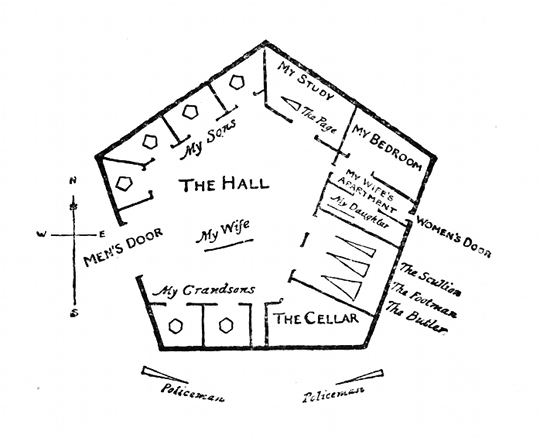

Flatland Society
Aside from the impending math lesson, Flatland was also a satirical commentary on London society.Much like the lower classes of England, the Flatlanders were under strict orders to never question authority or their own reality.
The portrayal of women as shrieking, dangerous, one dimensional beings was also satirical - Abbott was considered a feminist in his time.
Of the Nature of Flatland
How do Flatlanders see each other? "Place a penny on the middle of one of your tables in Space; and leaning over it, look down upon it. It will appear a circle.But now, drawing back to the edge of the table, gradually lower your eye (thus bringing yourself more and more into the condition of the inhabitants of Flatland), and you will find the penny becoming more and more oval to your view; and at last when you have placed your eye exactly on the edge of the table (so that you are, as it were, actually a Flatlander) the penny will then have ceased to appear oval at all, and will have become, so far as you can see, a straight line."
Of the Nature of Flatland
How do Flatlanders see each other?No matter what shape Flatlander has, they'll all just look like line segments (women could look like points).
Click to move from our view of Flatland to theirs:
Of the Nature of Flatland
Flatlanders have three methods for telling one another apart:- Art of Hearing: relies on voices to distinguish shape
- Art of Feeling: touching outside of a shape to determine their angles (used by lower classes and women)
- Art of Sight Recognition: using visual cues like "fog" to discern shape (used by upper classes)
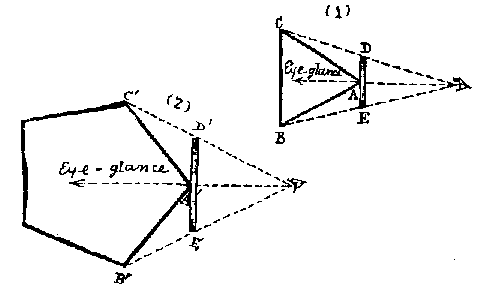
In Real Life
The issues faced by the inhabitants of Flatland are not unknown to us.Picture being an explorer, trying to make a map of an island but only traveling around its edges by boat.
We might do a good job of understanding its shape, but we can't fully appreciate it unless we have an overhead view, like from an airplane. In other words, we need to use that third dimension to understand the two dimensional outline of the island.
A Visit from A Sphere
One day, A Square is at home when he hears a voice, but no one is there.
The visitor tells A Square that he is from a different universe... one with THREE dimensions.
The visitor tells A Square that he is from a different universe... one with THREE dimensions.

A Visit from A Sphere
The visitors name is A Sphere, and he attempts to show A Square what he looks like by passing through Flatland.
A Square saw a series of cross sections, each of which was a circle.
Remember - A Square just saw the "outer wall" of the circle, he didn't have this nice overhead view like we do!
A Square saw a series of cross sections, each of which was a circle.
Remember - A Square just saw the "outer wall" of the circle, he didn't have this nice overhead view like we do!
A Visit from A Sphere
A Square, ever a skeptic, demanded more proof of this "third dimension".
A Sphere obliged by removing items from A Square's cabinets - without opening a door!
A Sphere obliged by removing items from A Square's cabinets - without opening a door!

A Visit from A Sphere
To A Square, this wasn't possible. A Sphere had passed through a solid boundary.
But really, A Sphere just used his ability to move in a direction that A Square could not. Just as we can see the entire inside A Square's house all at once.
But really, A Sphere just used his ability to move in a direction that A Square could not. Just as we can see the entire inside A Square's house all at once.

A Visit from A Sphere
To A Square, this wasn't possible. A Sphere had passed through a solid boundary.
But really, A Sphere just used his ability to move in a direction that A Square could not. Just as we can see the entire inside A Square's house all at once.
But really, A Sphere just used his ability to move in a direction that A Square could not. Just as we can see the entire inside A Square's house all at once.

What Does This Mean for Us?
A Square may never have been fully able to realize just what the third dimension would be like.
But through the demonstrations A Sphere gave, he could at least understand the ramifications:
But through the demonstrations A Sphere gave, he could at least understand the ramifications:

What Does This Mean for Us?
- Attempting to view an object from a higher dimension is impossible, but we can "reconstruct" what it might look like from projections (like the cross sections of A Sphere moving through the plane of Flatland)
- From the vantage point of a higher dimension, there is no "inside" or "outside" of objects in lower dimensions. The Sphere could see all of Flatland at once, even inside A Square himself!

What Does This Mean for Us?
We need to keep that first point in mind when viewing images of 4 dimension objects, like the tesseract.
Even a 3D model of one is just a projection into 3 dimensions. It's as good as viewing a circle as a projection of a sphere - we get the idea, but couldn't really picture a sphere from those projections.
Even a 3D model of one is just a projection into 3 dimensions. It's as good as viewing a circle as a projection of a sphere - we get the idea, but couldn't really picture a sphere from those projections.
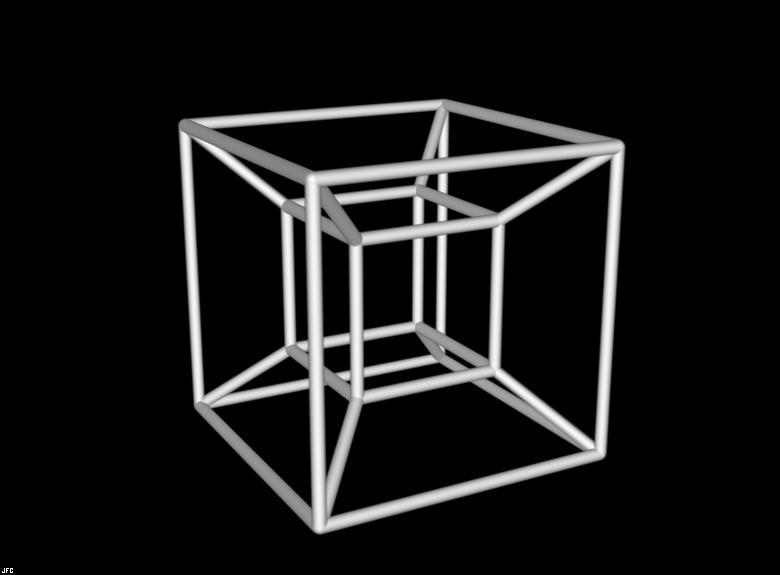
What Does This Mean for Us?
We may not be able to envision the fourth dimension, but we can try to imagine what our 3D universe would look like from the fourth dimension.
The key: there is no inside or outside to anything, just outlines.
The key: there is no inside or outside to anything, just outlines.

What Does This Mean for Us?
A 4D being visiting this classroom could see inside the room and outside it, all at once.
They could see inside your backpack, and read all the pages of your books even when they are closed.
They could see inside of YOU - your "outside" shape that everyone in our universe sees would just be a perimeter.
They could see inside your backpack, and read all the pages of your books even when they are closed.
They could see inside of YOU - your "outside" shape that everyone in our universe sees would just be a perimeter.

This is Weird
Abbott didn't claim to describe the fourth dimension in his book Flatland. He only gave us a way of considering it.
The truth is, his thoughts on the matter do not necessarily align with some other possible theories, one of which says that time is the fourth dimension.
The truth is, his thoughts on the matter do not necessarily align with some other possible theories, one of which says that time is the fourth dimension.
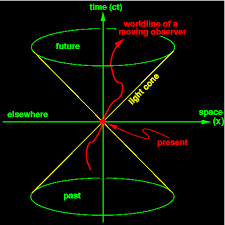
This is Weirder
The concept of time being the 4th dimension may be a little easier for us to understand.
If you wave your hand, it's position is described by three coordinates (in space) and the particular moment in which you measure it. So we could describe events using a place (in three dimension coordinates) and a time (the fourth component/dimension).
If you wave your hand, it's position is described by three coordinates (in space) and the particular moment in which you measure it. So we could describe events using a place (in three dimension coordinates) and a time (the fourth component/dimension).

Time or Space?
Abbott's book illustrated the view of most mathematicians - we can think of the fourth dimension as one of space, just one we can imagine due to our own 3D limitations.
The concept of time as the fourth dimension was (and is) of greater interest to physicists, as it filled an important piece of the puzzle that was the Theory of Relativity, put forth by Albert Einstein in 1905.
Here his in in front of a projection of a sphere
The concept of time as the fourth dimension was (and is) of greater interest to physicists, as it filled an important piece of the puzzle that was the Theory of Relativity, put forth by Albert Einstein in 1905.
Here his in in front of a projection of a sphere
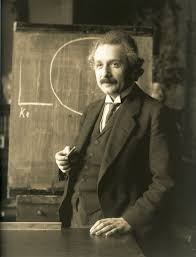
Everyone Has an Opinion
The debate over what the fourth dimension is began in the mid 1800s. At the time, a popular philosophy formulated by Auguste Compte, called positivism, was in direct opposition to even discussing it.Positivism held that our understanding of truth, nature, and the universe should be based only on our physical experiences. The fourth dimension can't be seen or felt, so it did not exist, and even if it does exist, it didn't matter.
Everyone Has an Opinion
“The positivists have a simple solution: the world must be divided into that which we can see clearly and the rest, which we had better pass over in silence. But can any one conceive of a more pointless philosophy, seeing that what we can say clearly amounts to next to nothing? If we omitted all that is unclear we would probably be left with completely uninteresting and trivial tautologies.”- Werner Heisenberg, physicist, 1969
Everyone Has an Opinion
“The positivists have a simple solution: the world must be divided into that which we can see clearly and the rest, which we had better pass over in silence. But can any one conceive of a more pointless philosophy, seeing that what we can say clearly amounts to next to nothing? If we omitted all that is unclear we would probably be left with completely uninteresting and trivial tautologies.”- Werner Heisenberg, physicist, 1969
In other words, it's valuable to think and learn about things, even if they are not immediately obvious or useful.
What great advice!
The Fourth Dimension in Literature
"I have a Euclidean earthly mind, and how could I solve problems that are not of this world? And I advise you never to think about it either, my dear Alyosha, especially about God, whether He exists or not. All such questions are utterly inappropriate for a mind created with an idea of only three dimensions."- Brothers Karamazov, Fyodor Dostoevsky, 1880
The Fourth Dimension in Literature
"There was evidently no time to be lost, so, hastily adopting the Fourth Dimension of Space as a means of escape, he vanished through the wainscoting, and the house became quite quiet."- The Canterville Ghost, Oscar Wilde, 1887
The Fourth Dimension in Literature
"Has it never glimmered upon your consciousness that nothing stood between men and a geometry of four dimensions - length, breadth, thickness, and duration - but the inertia of opinion? When we take up this new light of a fourth dimension and reexamine our physical science in its illumination... We find ourselves no longer limited by hopeless restriction to a certain beat of time."- The Time Machine, HG Wells, 1895
The Fourth Dimension in Literature
The fourth dimension shows up frequently in contemporary fiction as well.In Slaughterhouse Five, Kurt Vonnegut explains that doctors were unable to cure mental illnesses, as their causes lie in the fourth dimension.
In A Wrinkle in Time, Madeleine L’Engle describes geometric shortcuts throughout the universe in a process called "tessering".
This is NOT a Physics Class
We won't get into the debate on Relativity here (but take Physics classes if you're intrigued!).
What we do know is that the fourth dimension is necessary for mathematics, and can be viewed in many ways.
If we're having trouble visualizing anything, perhaps artists could help.
Like Pablo Picasso!
What we do know is that the fourth dimension is necessary for mathematics, and can be viewed in many ways.
If we're having trouble visualizing anything, perhaps artists could help.
Like Pablo Picasso!
